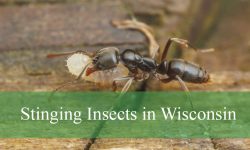Woodpeckers in Arkansas bring lively colors and distinct sounds to the state’s diverse bird population. Notable species include the Hairy Woodpecker, known for its black and white check pattern, and the Red-Headed Woodpecker, recognized by its vivid red cap.
The Downy Woodpecker, with its black and white plumage, is commonly found in wooded suburban areas. Conservation efforts are crucial for the survival of endangered species like the Red-cockaded Woodpecker.
Birdwatchers exploring Arkansas may also catch a glimpse of the elusive Ivory-billed Woodpecker, a subject of occasional debates despite its declared extinction.
Arkansas’s diverse habitat creates an ideal haven for woodpeckers, offering a rich and rewarding experience for bird enthusiasts.
Different types of Woodpeckers in Arkansas
Hairy Woodpecker
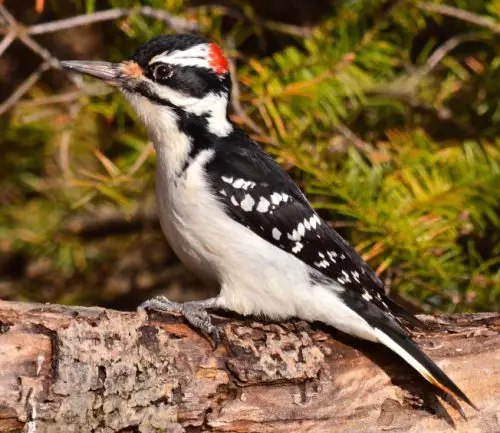
Because of their long, thread-like white feathers on their all-black backs, Hairy Woodpeckers receive their moniker. These medium-sized birds are less numerous than Northern flickers in Arkansas, but they can still be seen in backyards with bird feeders, parks, cemeteries, and suburban forested areas.
Unlike migratory birds, Hairy Woodpeckers remain in one place and are more noticeable in the winter months because they typically nest in dead trees. Their long beaks, pastel bellies, and black and white plumage are some of their distinguishing characteristics. They have an average wingspan of 35 cm, a length of 18 to 26 cm, and a weight of 1 to 4 ounces.
It’s easy to tell the genders apart: the male Hairy Woodpecker has a crimson patch that can be seen on his nape. Males scream out in a shrill, high-frequency manner, and they drum quickly on trees.
In addition to spiders, bees, and caterpillars, the primary food source for Hairy Woodpeckers includes larvae of ants and beetles.
Red-Headed Woodpecker (Melanerpes erythrocephalus)
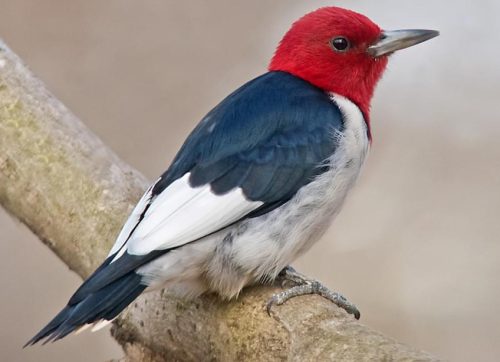
While not as common as other woodpeckers, the Red-Headed Woodpecker (Melanerpes erythrocephalus) can still be seen in Arkansas in the summer and winter. It is breathtakingly beautiful when spotted infrequently, making the meeting unforgettable.
These woodpeckers are year-round residents of Arkansas, but habitat loss has reduced their numbers. By placing suet or citrus on bird feeders, backyards can draw them in for observation, particularly during the winter. They live in parks, orchards, forests with dead trees for nesting, and woodlands.
Young red-headed woodpeckers have pale red cheeks and white dots on their wings, giving them a dark brown to black coloration. When they reach adulthood, their heads, necks, and napes change to a deep, velvety crimson, which contrasts with their underbelly of white and their solid-black wings. Adults can grow to be between 2 and 3.5 ounces in weight, 21 to 25 cm long, and 35 cm wide on average.
Red-Headed Woodpeckers make a variety of sounds, such as laughing and chirping, but they are most known for their “shrill tchur,” a high-pitched call that rolls less.
These woodpeckers hunt for nuts and seeds, which they then store for the winter in tree bark or holes. They also fly up and collect insects, a behavior unique to woodpeckers.
Downy Woodpecker (Dryobates pubescens)
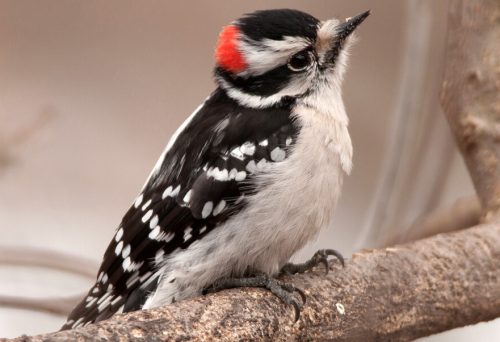
Despite being the tiniest woodpecker in Arkansas and the United States, the Downy Woodpecker (Dryobates pubescens) is just as fascinating as its larger relatives in the state.
Downy woodpeckers are year-round inhabitants of Arkansas who choose the state’s reliable weather over migration. They live in tree cavities and build their nests in parks, forests, groves, and backyards in both rural and urban areas. In Arkansas, hanging a suet feeder in your yard is a good way to draw them in during the winter.
Though much smaller than hairy woodpeckers, downy woodpeckers are distinguished by their dotted wings, white chest, and black and white feathers. Male adults have red patches on their heads.
When establishing territory or looking for a partner, downy woodpeckers beat quickly on trees and make high-pitched, whiny noises. In addition to hunting for ants, caterpillars, beetle larvae, and other insects, their varied diet consists of peanuts, sunflower seeds, cereals, berries, acorns, and suet.
Yellow-Bellied Sapsucker (Sphyrapicus varius)
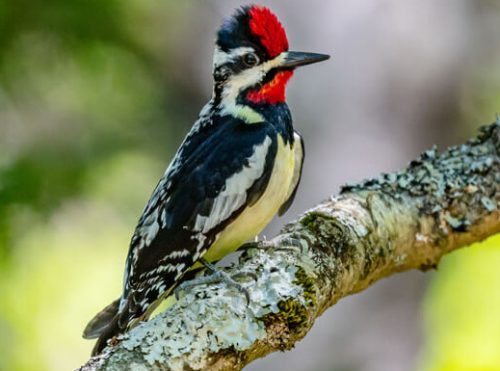
Though diminutive in stature, the Yellow-Bellied Sapsucker (Sphyrapicus varius) is the most widely distributed woodpecker in Arkansas, breeding from coast to coast in Canada and wintering back in Arkansas.
These sapsuckers live in different parts of Arkansas during the non-breeding season, favoring tall trees in woodlands over household suet feeders. They are black-and-white, medium-sized, and may be recognized by the stripe on their shoulders. The sizes of both sexes range from 1.5 to 2 ounces, 20 cm in length, with an average wingspan of 37 cm. They have pale yellow underbellies, as the name implies, and males have red foreheads and throats, while females have less vivid yellow and white throats.
Yellow-Bellied Sapsuckers produce a unique nasal mewing sound and a territorial, squealing, repetitive call during breeding season. Their diet consists of wild berries, fruits, flying insects, sap, and sapwood.
Red-bellied Woodpecker (Melanerpes carolinus)
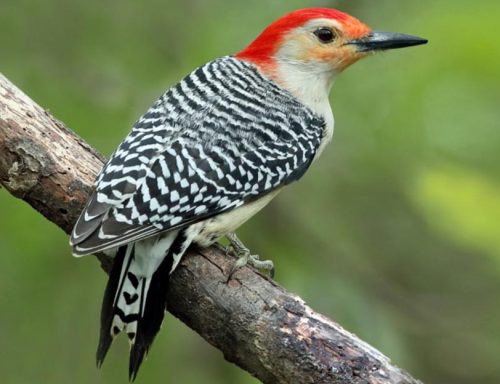
Despite their medium size, Red-Bellied Woodpeckers (Melanerpes carolinus) are easily recognized in Arkansas woodlands thanks to their striking black and white striped backs and brilliant red crowns.
These year-round residents of Arkansas prefer to nest and drum on oak and hickory trees or in wooded areas, and they frequently return to the same tree each year. Red-bellied woodpeckers are smaller with creamy white bellies, and they are often confused with red-headed woodpeckers because of their similar red heads. Feathers of both sexes are striped in black and white, growing to a weight of 2 to 3.2 ounces, a length of 22 to 27 cm, and an average wingspan of 42 cm. Males have a red crown and nape, females have a red nape.
Red-bellied woodpecker males tap on trees to attract females, creating a drumming sound that is audible from early winter until late spring. Rolling “churr” or “kwirr” calls are made by both sexes. Unlike other woodpeckers in Arkansas, red-bellied woodpeckers have a different diet; they eat more fruits, such as wild berries, than insects.
Red-cockaded Woodpecker (Leuconotopicus borealis)
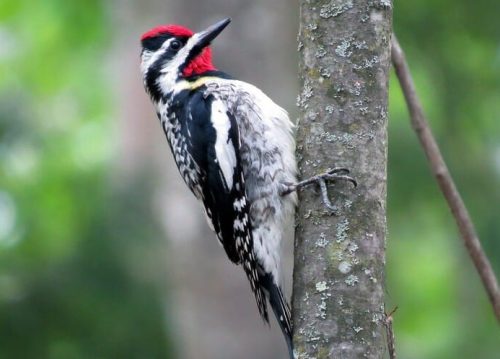
The Red-cockaded Woodpecker holds the distinction of being the sole woodpecker species listed as endangered since 1970, primarily due to logging activities. In Arkansas, most of these woodpeckers inhabit longleaf pine areas, and concerted conservation efforts aim to safeguard their thriving existence within the state.
Characterized by medium size, black and white feathers, a black cap, black nape, and white facial feathers, these woodpeckers exhibit red stripes on their cheeks exclusive to males. Emitting a distinctive, raspy “sklit” call when feeling threatened or disturbed, they also have a general call resembling a typical “churt.”
Ivory-billed Woodpecker (Campephilus principalis)
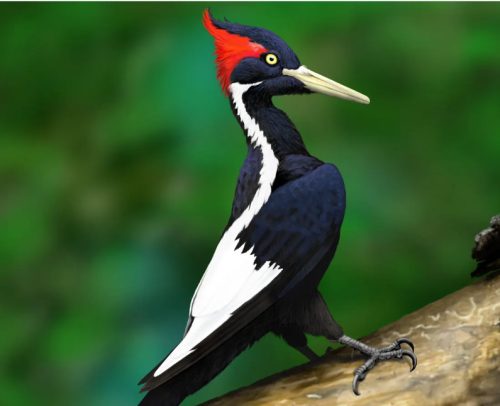
The Ivory-billed Woodpecker, regarded as one of the most beautiful woodpeckers in the world, tragically went extinct in 1944; the last record of its sighting was in Louisiana. A sighting recorded in eastern Arkansas in 2015 gave fans a renewed sense of hope and enthusiasm.
Subsequent sightings and efforts to restore the bird’s habitat have spurred ongoing discussions regarding the bird’s existence. Some who are skeptical claim that these findings could be mistaken for the very identical Pileated Woodpecker, which can be identified by its thick white back.
The prospect of Ivory-billed Woodpeckers remaining exists because the U.S. Fish and Wildlife Service prolonged the species status review to January 2023 as of July 2022.
Lewis’ Woodpecker (Melanerpes lewis)
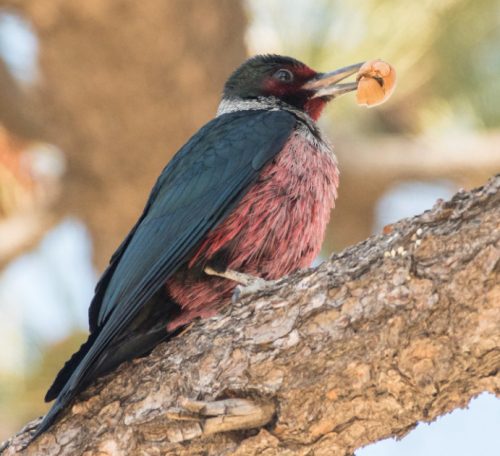
Having only been observed four times at Mount Sequoyah, Lewis’ Woodpeckers (Melanerpes lewis) are now considered an incidental or unusual species in Arkansas and have been placed on the yellow watch list due to their diminishing population. With their black heads, red cheeks, black wings, grayish collars with a hint of white feathers on the chest, and pinkish and red underbellies, these woodpeckers have a distinctive appearance.
Adults weigh 3.1 to 4.9 ounces, with a wingspan of 19.3 to 20.5 inches, and are among the biggest woodpeckers in Arkansas. Their length is approximately 10.2 to 11.0 inches. Pine, cottonwood, paper birch, and any other dead or rotting tree are good habitats for Lewis’ Woodpeckers. It’s interesting to note that they rarely construct their own nests, instead choosing to live in those made by other woodpeckers.
Northern Flicker (Colaptes auratus)
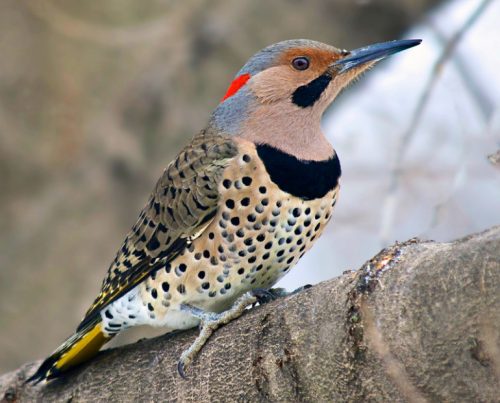
When it comes to being the most accessible woodpecker for beginning birdwatchers in Arkansas, the Northern Flicker is a great choice because it is there all year round. In the winter, Northern Flickers migrate to warmer regions; a significant population of these birds resides in Arkansas. The birds migrate from Canada and Alaska. Arboreal habitats such as parks, cemeteries, and residential areas are home to these woodpeckers.
Northern flickers are distinguished by their enormous size; their physical attributes differ according to gender and age; on average, they measure 30 to 35 cm in length, 4 to 7 ounces in weight, and have a 54.1 cm wingspan. They have black markings on their breast and back, and their general hue is grayish brown. Their dazzling white feathers around the rump are very noticeable while they are in flight. They have yellow or red tails in the eastern US, which includes Arkansas.
Northern Flickers are distinctive in their voice during the spring mating season. Regarding food, Northern flickers graze on insects such as caterpillars, ants, beetles, and termites by excavating the ground, in contrast to other woodpeckers that hunt in trees.
Pileated Woodpecker (Dryocopus pileatus)

Visitors to Arkansas are lured by the opportunity to see the magnificent Pileated Woodpeckers, a protected species that demands consideration when taking pictures or movies.
In Arkansas, pileated woodpeckers live in old woodlands, forests with fallen logs, and dead trees. They are year-round residents. Additionally, they can be found in a variety of locations, such as parks, golf courses, and backyards in both rural and suburban areas.
Unless they believe that their nest is too dangerous for their eggs, these woodpeckers are steadfast in their refusal to move, spending their entire lives in a certain town or state. Pileated Woodpeckers are about the size of crows, but they are distinguished by their vivid red crest against their black and white striped backs. Men may have a red line running down the side of their faces.
One of the biggest woodpeckers in Arkansas, adults can reach a maximum length of 40 to 50 cm, weigh 8 to 13 ounces, and have an average wingspan of 70 cm. Their remarkable appearance could make onlookers think of the Woody Woodpecker cartoon character, who was presumably modeled after this type of bird.
Considering their size, Pileated Woodpeckers can make tremendous drumming noises, with up to 30 taps in a single second. All year long, both sexes engage in this year-round drumming to draw potential partners or mark territory.
In terms of food, Pileated Woodpeckers forage for insects and larvae on the ground and in dead trees, especially their preferred carpenter ants. They sometimes eat nuts and berries, fastening their discoveries to branches.
People Who Read This Also Read:





